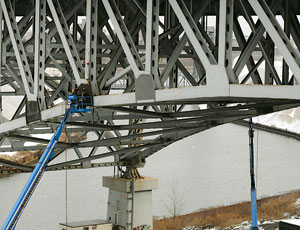Ohio Dept. of Transportation officials and Cleveland Mayor Frank Jackson are locked in discussion over whether ODOT should close one of the city’s major bridges that is rapidly deteriorating.
The 5,078-ft-long Inner Belt Bridge, a cantilevered steel-truss structure similar in design to Minneapolis’ Interstate 35W bridge, was scheduled for rehabilitation until recent inspections prompted the state to propose closing it and building a replacement over two years. Jackson says closing the bridge, which carries I-90 through downtown, would choke off a needed economic lifeline. It carries nearly 120,000 cars per day.

The 50-year-old bridge’s problems have been known for some time. ODOT rated it as “poor” in 2006-07. After the I-35W collapse, ODOT officials performed more detailed inspections, resulting in a ban on heavy truck traffic and a $2-million contract in May 2008 to reinforce the structure, including 34 deteriorated gusset plates. Detailed ultrasound testing in November revealed further problems, prompting officials to limit traffic to two lanes each way across the bridge from the existing four lanes each way.
Unlike the Minneapolis span, the Inner Belt Bridge’s problems are not related to design errors of gusset plates but to general rusting and deterioration of the structural steel, including the gusset plates, according to ODOT.
For several years, ODOT officials have been developing a phased plan to extend the life of the span and build an adjacent new bridge. Costs were estimated at $175 million to extend its life, and $350 million for a new cable-stayed bridge. Each would carry five lanes of traffic, one bridge for eastbound traffic, the other for westbound.
But the rapid deterioration of the I-90 span has ODOT rethinking its approach: officials now are considering closing the bridge entirely for a period of up to two years to build a replacement span in the existing right-of-way.
The plan would keep the bridge open while foundation work beneath the existing bridge is done. ODOT estimates the cost of a replacement bridge in the range of $200 million, according to spokesman Scott Varner.
Jackson says the economic impact of the bridge closure makes the plan unacceptable. He wants ODOT to minimize the economic impact and guarantee that funds saved by building the single replacement bridge would be used for other pressing transportation needs in the city. A spokesman for the mayor says negotiations with ODOT are ongoing.
Varner says all options are still on the table, and a decision could be made by next spring. The agency is preparing to let a contract in January to further reinforce key structural members of the bridge. The contract, estimated in the $10- million range, would add a margin of safety while ODOT ponders its options.

Post a comment to this article
Report Abusive Comment